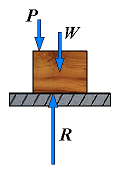
φ < φs
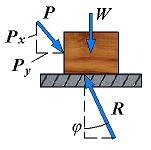
φ = φs
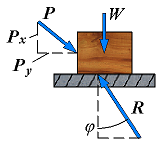
| Angles of Friction |
| symbol | description |
| φs | angle of static friction |
| φk | angle of kinetic friction |
| μs | coefficient of static friction |
| μk | coefficient of kinetic friction |
| N | normal component of the reaction surface |
| No friction | R = N |  | If no horizontal force is applied to the block, the resultant R reduces to the normal force N. |
| No motion | F = Px φ < φs |  | However, if the applied force P has a horizontal component Px which tends to move the block, the force R will have a horizonatal component F and, thus, will form an angle φ with the normal to the surface as shown. |
| Motion impending | Fm = Px φ = φs |  | If Px is increased until motion becomes impending, the angle between R and the vertical grows and reaches a maximum value. |
| tan φs = |
| = |
|
| tan φs = μs |
| Motion | F = Px φ < φs |  | If motion actually takes place, the magnitudes of the friction force drops to Fk; similarly, the angle φ between R and N drops to a lower value φk, called the angle of kinetic friction. |
| tan φk = |
| = |
|
| tan φk = μk |
| No friction | R = N | 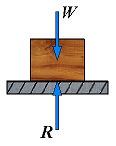 | If the base is horizontal, the force R exerted by the board on the block is perpendicular to the base and balances the weight W. |
| No motion | F = Px φ < φs | 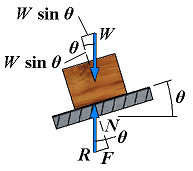 | If the base is given a small angle of inclination, θ, the force R will deviate from the perpendicular to the base by the angle θ and will keep balancing W; it will then have a normal componenet N of magnitude N = W cos θ and a tangential component F of magnitude F = W sin θ. |
| Motion impending | Fm = Px φ = φs | 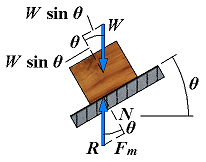 | If the angle of inclination continues to increase, motion will soon become impending. At that time, the angle between R and the normal will have reached its maximum value φs. The value of the angle of inclination corresponding to impending motion is called the angle of repose. Clearly, the angle of repose is equal to the angle of static friction φ. |
| Motion impending | Fm = Px φ = φs |  | If the angle of inclination θ is further increased, motion starts and the angle between R and the normal drops to the lower value φk. The reaction R is not vertical any more, and the forces acting on the block are unbalanced. |
| ⇐Previous Lesson: Laws of Dry Friction and Coefficients of Friction | Next Lesson: Encountering Dry Friction⇒ |